 |
| Rathous in Munich |
|
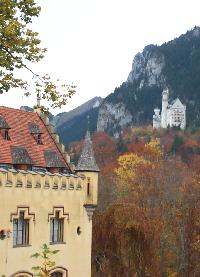 |
| Hohenschwangau and Neuschwanstein |
A bit of other background: The dollar was very strong compared to the Euro during October 2000. 1DM was about 43 cents currently, and it has been over 60 cents in the past. This meant everything was a bit of a bargain, and I was prepared to buy a lot of games.
Our hotel reservations had been slightly messed up and we had reservations starting Thursday night, rather than Wednesday, but we wanted to be close enough to get there early in the morning, so we decided to try to stay in Dortmund, less than an hour away. We found a hotel, which reeked overwhelmingly of cigarette smoke, which was to be an omen for the whole experience. As most Europeans, the Germans smoke a lot.
My German language skills are pretty limited. I had been to Germany once, ten years ago, and learned a very little German, and have picked up a bit more playing these games. Mostly, however, we just asked people if they spoke English.
We got an early start out of Dortmund, to get to Spiel early, since we didn't know exactly where we were going. As we drove into Essen, signs advertising Spiel were everywhere. We arrived at Messe-Essen, the convention center where Spiel is held, and parked, for 5DM. We had arrived about 8:55am, and the show didn't start until 10am. The weather was ok, but not great. Overcast, cool, but tolerable. Promptly at 9am, the ticket sales started. We got a couple of the 4-day passes and a guide book and went inside to try to find breakfast, as we were both very hungry and had not yet eaten. After a little while, a cafeteria opened up, and we got some breakfast.
As we sat and ate breakfast, waiting for the door to open, I ran into Aaron Fuegi, from the area, and several English folks. I read the guide book, and peered through the windows at the massive booths and displays the game manufacturers had set up. Hundreds of people were already waiting to be admitted. While we were waiting, I saw Reiner Knizia come in, and after he spoke to some other folks, I said hello (I had met Dr. Knizia before when I invited him to speak at MIT a year and a half ago). and caught up with him for a minute, after which he went into the hall, and we continued to wait.
 |
| A peek into the halls |
We mapped out where we wanted to go first, which was to do a quick once through all the halls and to the "limited edition" game booths that we were interested in.
As we entered, many people immediately sat down to play a game. I had far too much adrenalin to sit still, and had to go see everything. We stopped briefly by the Counter booth to say hello, meet a few of the other English speakers who were about, and renewed my subscription. The basic layout of the halls was as follows: Hall 12, dominated by the Kosmos booth was by the main entrance, and actually didn't have many large booths, other than Kosmos. Through here you entered into Hall 11 and 10, where were really one big hall, and had the majority of the huge booths, and many of the sellers of new games. Past that was Hall 9, which was mostly small publishers and some less game related stuff. Halls 6 and 8 were past this, and contained miniatures, RPGs (Rollenspiel), and wargaming stuff, and most importantly, the used game dealers. Additionally, there was hall 5, which had lots of children's stuff (mostly not board games), and halls 6.1 and 9.1, which contained "Comic Action", the associated comic book convention.
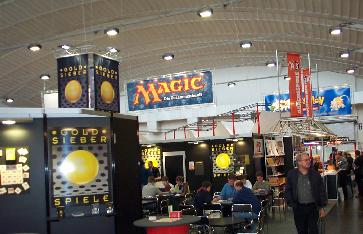 |
| Hall 10/11 |
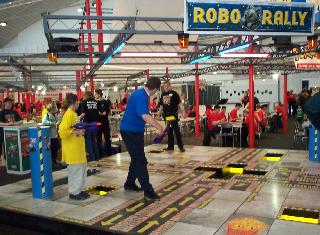 |
| Live Action RoboRally |
We gawked a while at these booths, and headed to Hall 9, where many of the limited edition games had their booths. I don't recall the exact sequence of events here, but we went to the Cwali booth, played a game of Morisi, and bought a copy (the first signed game of the trip). Morisi is beautifully produced and is fun to play. I'm eager to try out the multiplayer play. From here, we went over to the booth where Lunatix Loop was being sold, got a brief description, and purchased a copy of that, which we have yet to play.
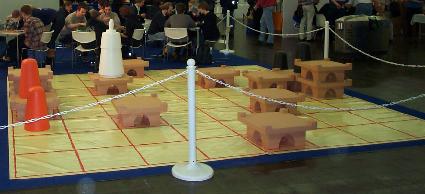 |
| Super Sized Torres |
After all of this, and having purchased more games than I've
mentioned, we decided to drop things off at the car, and get another
piece of luggage in which to carry games. We looked at our watches,
and saw that it was only noon. Wow.
 |
| The Queen Booth |
Following this, we walked through Hall 9 again. We stopped by the booth of a company which had these cute looking tree sculptures. The attendant spoke English ok, but not fluently. Through a combination of some English and lots of gesturing and examples, they explained their game, "Arbos: Das Baumspiel" aka, The Tree Game. Basically, it's Jenga, but with a tree instead of a tower. Ok, it's not really quite like that. You have this stump. It's got holes in it. You've got branches and leaves, and you take turns sticking them in holes and whatnot trying not to knock anything else down. It also comes with a whole bunch of cards with german instructions on what to do to the tree (add one piece, remove two pices, add three leaves, etc), and it wasn't clear how these were supposed to be used, but we were encouraged to "make up rules". It's cute, it's fun, and it's pretty. We bought it.
 |
| The Kosmos Booth |
We bought more games on Thursday, and when we left it was pouring rain. Fortunately the games avoided damage with the exception of a little bit of water on Igel Argern. We finally went to check into our hotel, which was very nice, but very modern in design. Our hotel room was all angular, stainless steal, black leather almost to the point of being comical. Fortunately, it was a mere 5 minute drive from the halls and comfortable enough.
Friday, we got in a little later, and bought even more games, and played quite a few. We spent a little while Friday shopping for gifts for family and friends, in particular my 7 year old cousin. I'll write more about this quest in a later part. When we got to the hotel that evening, we did a "test packing". We had brought two large pieces of empty luggage, and found that so far, we had 90% filled one of them. We had more shopping to do.
 |
| Crowds at Essen |
Sunday was much more subdued, though still crowded. We forgot about daylight savings time, so got up too early, but fortunately, there was a sign mentioning it in our hotel lobby. We finalized our shopping list and decided to try to play a few more games on Sunday than we had before. We ended the day with possibly more games than we had luggage space for, but feeling extremely pleased with the whole experience.
As mentioned above, from here on in, I'm going to take a much more
free form rather than sequential approach.
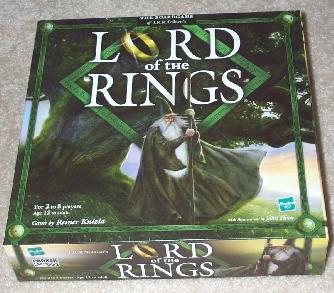 |
| Lord of the Rings |
The game itself is beautiful. I was surprised at the size of the boards (they're quite large). Somehow, from the pictures, I was expecting them to be smaller. The artwork on the boards (all the art is by John Howe) is striking, atmospheric, and very well done. There
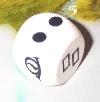 |
| The Dark Die |
The next morning, we failed to arrive as early as we hoped, but apparently it would not have helped, as the general German attendees had usurped Dave's table, and his copy of the game was locked in a closet for which he had no key. When we arrived in the afternoon, there was a game in progress, and we started a sign up sheet for a later play. We went off to look at and play other games. We played Cafe International, which was cute, and we later picked up for 30DM (= $13.25), which made it an "expensive" game. We arrived back at the Lord of the Rings table at our appointed time, and there was one, of the three other people who were supposed to be playing there. Dave started explaining the rules, figuring the remaining players would show up. By the time he finished with the rules, the players had not shown up, so we played with three, at the medium difficulty level. Our third party, who's name I have forgotten was Frodo, I was Sam, and Carrie was Pippin.
The details of gameplay has been described elsewhere, so I'll only give a cursory description here. Basically, there are 6 stages the hobbits have to travel through in order to destroy the Ring, four of which are associated with boards.
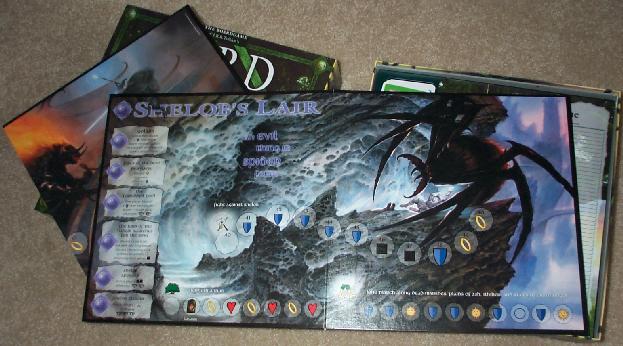 |
| Shelob's Lair board |
We left Bag End in good spirits, having made extra preparations, and traveled through Rivendell without any trouble. We zipped through Moria relatively unscathed, and thought we were looking quite good, though Frodo was somewhat corrupted. In Lothlorien, we passed the test of Galadriel, and headed on to Helm's Deep, where things took a turn for the worse. Frodo was percariously close to corruption by Sauron, and despite I (Sam) being the Ring Bearer at the moment, it appeared Frodo would again bear the ring, which made him a high risk for corruption. We zipped through Shelob's Lair as quickly as we could, heading straight into Mordor. Twice, we had to save Frodo from the clutches of Sauron, and we (Sam and Pippin) rapidly were becoming subject to his evil influences. In Mordor, Pippin was the Ring Bearer, and was convinced to slip the ring on right near the end, and bring the ring to be destroyed, which Pippin did successfully did! We had destroyed the Ring, and we had all survived.
This is one of the most atmospherically/thematically effective games I've ever played. Partway through the game (toward the end), I found myself physically tensed up, concerned we would not succeed in destroying the Ring. It is wonderfully involving. The gameplay and negotiation of who would do what to best serve the group was fun and involving. One of my major concerns with this game was that the cooperative gameplay would make it feel like group solitaire or something. It didn't. The fact that each player is genuinely seperate (may die seperately, has seperate cards, can help or hinder the group individually) gives a strong sense of identity (Sam, I am), while the group goal was still primary. The feeling of "I want to save the Ring, but if someone has to die in the process, let it not be me" was good.
 |
| The hobbits, Sauron and the Ring |
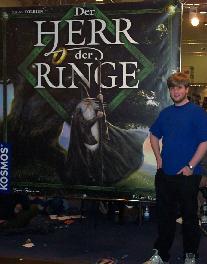 |
| Me (and a big sign) |
All over, booths had copies of "Der Herr der Ringe". By the way, "Ringe" does not rhyme with "cringe". It rhymes with "finger" (at least the way we pronounce "finger" up here in Boston). I was fortunate enough to get a copy of the English version, and was eager to play again. Carrie thought it was fun and quite suspensful, but was more interested in playing new games, since we could play Lord of the Rings again, once we returned home. Replay value is something that seems it might be a slight issue with this game, though I'm optimistic about it. When the game ends, you get a score (as a group and/or individuals), which there is a definite feeling of "lets beat that next time". We got 69.
That evening, I realized it would really be great if I could get the game signed by Dr. Knizia, but also didn't want to lug the game around for all of Saturday. So, I packed up the main board, which is fortunately somewhat smaller, and put it in the bag for the next day. I was told Dr. Knizia would be at the Merz-Verlag booth around 11am, and figured I'd stop by for an autograph. Of course, at 11am, I was in the middle of a game (Port Royal, which I thought was fun and Carrie liked a lot) which I didn't want to interrupt, so I missed him. I figured I'd have to be more than content with just a copy of the game, or try to catch him on Sunday.
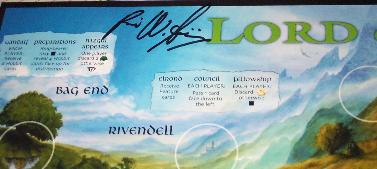 |
| My Signed copy |
So, to sum up, I loved Lord of the Rings. It's a fun, involving, beautiful, well-executed, novel and compelling game. Repeat playability is an open question, but I hope to have an answer to that soon, and if you're uncomfortable with a cooperative game, the competetive variant may not fully satisfy you, though I haven't tried it yet. The game still manages to somehow feel a little competetive anyway, which I think is a good thing. This is in part due to the rule which says, if you happen to be overcome by Sauron while you are the Ring Bearer, but have at least 3 of the Ring tokens, you join Sauron and win. The rules describe this as part of the competetive variant, but I thought Dave described it as just one of the rules. I like this twist, because it adds an appropriate level of suspicion of your teammates.
I expect to play it again this afternoon, at which point I will update this with my thoughts on "repeat" play, insofar as "repeat" means twice. Update: I've played it again, and at least the second time, it was still a blast, and I'm still eager to play again, so my repeat playability concerns seem unfounded.
I have a cousin who's about 7 years old. Last year, we got her Sagaland (Enchanted Forest) for the holidays and it was a big hit. So, it was a particular mission at Essen to find something suitable for her. While the show was dominated by the more complex games, there were still a lot of children's games. In fact, all of Hall 5 was dedicated to kids playstuff, although most of that wasn't actually games.
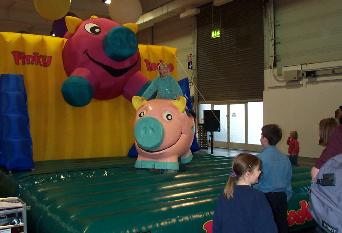 |
| Pinky Rodeo |
So, we looked for a game suitable for my cousin. We walked by one booth, which had some very cute looking children's games, including a pretty game about a little tiger. Unfortunately, we rapidly found out that they weren't actually selling at the show, but were just looking for distributors and the like. We got their web site for future reference, which I don't recall at the moment (but I have written down, somewhere :-) We moved on.
|
One game we had seen, a couple booths down from Counter, was "So ein Zirkus", which we wanted to try. So ein Zirkus is another very pretty wooden game, with circus clowns. The circus clowns are actually a wooden tube, in which marbles may be places. The board (also wooden), has several "potholes" which are marked with a number of stars. The board is a rectangular grid 3 x about 12. Each player gets a color. On a players turn, they roll a die, which has several colors on the faces. The player may either put a marble of that color into a clown, or move a clown which has that color marble as the top showing one. If they player moves the clown, they may move it the number of spaces equal to the number of marbles it contains, so a fully loaded clown moves rather quickly. In fact, it must move that many spaces, if possible. The clowns may not move backwards, except if white, the wild color is thrown. It was cute, but not as much fun as I hoped. The clowns are very cute, and the mechanisms are nice, but a few lucky die throws seems to decide the game. We liked it enough that we decided it made a decent "back up" game, in case we didn't find anything else we liked more. Then, we found ZappZerapp.
 |
| ZappZerapp |
|
Wow, is Zapp Zerapp fun. Distinguishing 1 BB from 2 from 3 is easy. Distinguishing 9 from 10 is a bit harder. The art and pieces are very attractive (each players pawns are different colors and different shapes) and the cauldrons are nice wooden pieces (some assembly required). The game itself actually has a little bit of strategy, with the safety zones, pawn selection, sending opponents back, the "tower" spaces, and having some freedom of choice as to how far you move (you can intentionally choose a cauldron substantially lower than the die roll). We loved it. We grabbed two copies; one for my cousin, and one for us. Along with Lord of the Rings, Zapp Zerapp was the other big hit of Essen for us.
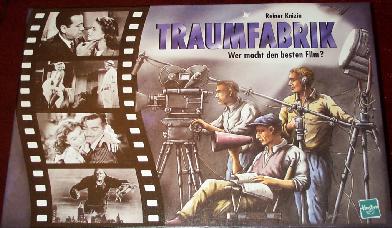 |
| Traumfabrik |
He did a good job of explaining the basic rules, but was a little fuzzy on some fundamental things like scoring. It looked cute, but I was not extremely impressed. Carrie had a good feeling about it, so we bought it. We brought it back to the states, and managed to play it with a friend who speaks fluent German and she was kind enough to help us clarify the rules (thanks Alison!). With the correct rules, this is a great game. Carrie was pleased to say "I told you so", and I was pleased she was right.
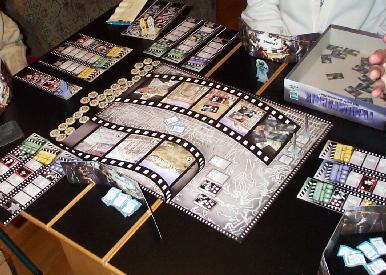 |
| Traumfabrik being played (board is inverted in photo) |
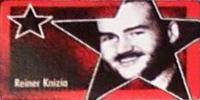 |
| Reiner Knizia, Star |
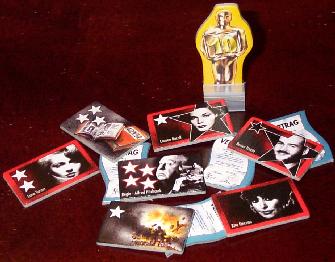 |
| Traumfabrik bits |
To expand a bit on the chrome: it's all about old movies, though some of the actors were young in the 40s/50s so some have done quite a bit since then :-) Only the actors, Stars, and directors (and then, only the 4 star directors) have names. The music, special effects, camera work, and directors are all nameless. The movie mix is good, ranging from Casablanca to King Kong to Bambi, to several that we couldn't figure out. "This Fist in the Neck" (in German) was figured out to be "On the Waterfront", but we still don't know what "Der Hofnarr" is, for example. There is no language other than the actor names (including "Gary Grant", oops) and the word Vertag (contract) on the contract chits. Oh, and the word "Agenten" or something on the agent chits.
There are several other nice twists such as the use of Agents (wild cards), rules for breaking ties for awards between movies (basically, first is better), the Parties, and the fact that everything except the number of contracts you currently have is open information makes for an outstanding game. Additionally, it plays in a reasonable amount of time (about an hour, maybe less), and feels like there's a good variety of playing strategies and bidding tactics to explore. I recommend this one strongly.
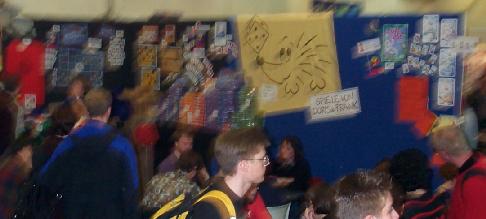 |
| The Doris & Frank Booth |
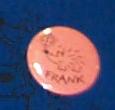 |
| Frank's Button |
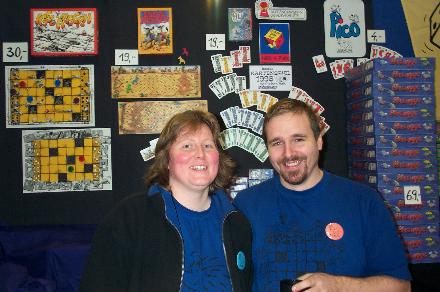 |
| Doris & Frank |
Near Cwali was the Krimsu booth, where they were hawking both their new games (Strand-Cup and Haps) as well as their older games. I hadn't read much about any of these games, but they had a very good "package deal" on their two new games, and I knew they published English rules on their web site that I picked up Haps and Strand-Cup, neither of which I've had time to play yet. Also in this hall was Splotter, which I'll talk about below and a number of other small publishers, often of abstract games, as well as many atypical booths. One booth was selling comfy hanging chairs. Another, syringes and ink for refilling ink jet cartriges. Another, a drafting tool thing. I'm not quite sure how these have to do with games, but there they were.
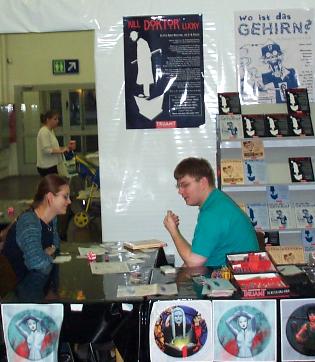 |
| Cheapass games, in German |
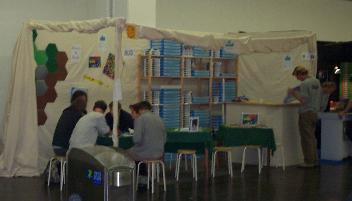 |
| Splotter booth (everyone's crowded around Roads & Boats) |
A couple of other small publishers were over in hall 11, including 2F-Spiele which has a new game, FlickWerk. The bright-green haired author was on hand and gave us the explanation. We played a quick round of this. The basic idea is you are laying out the network in an office, with various constraints. The game is a puzzle game and plays with up to four with one set. It's lite and quick, and will make a good between-game game. Nearby was Spielteufel which had been very crowded earlier in the show, and was less crowded on Sunday. Unfortunately, this was because the game that sounded most interesting, "Der Welt der Winder", had sold out. We got an explanation of it, and it sounds like a novel race game. We also got a demo of "Schwimmer in der Wuste", which was very pretty with many painted rocks. Unfortunately, it was a bit abstract for my taste, and we opted not to get it. They did have on of their older games, which shows (among other cows) a cow being struck by lightning on the cover. We picked that one up. There's something neat about a game with a theme of cows eating grass. We haven't played this on yet either (sense a theme here?), but it looks like a lot of fun (and they had English rules).
That's about it for small publishers now. I'll talk a little about Adlung Spiele games and GMT in a later section.
next... booths full of wooden bits, used games galore, tips
for future visitors to Essen, pronunciation, rollenspiele, bringing
lunch, ATMs and much much more :-)